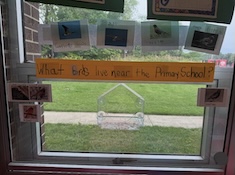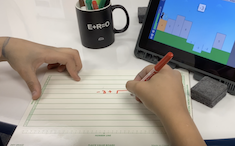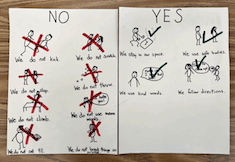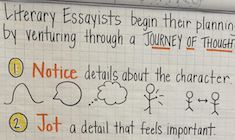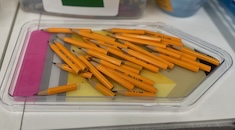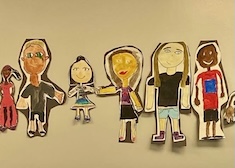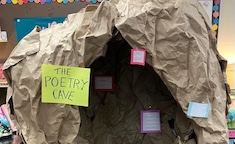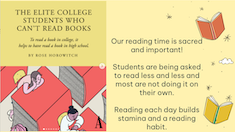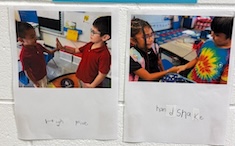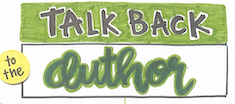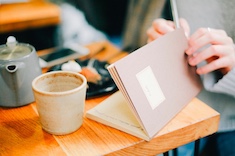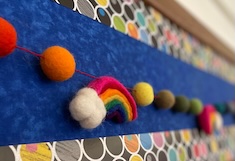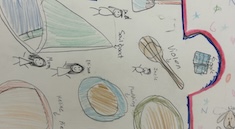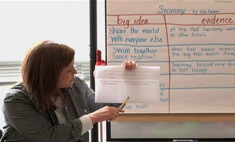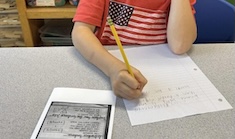Articles
Here is where you’ll find all the latest print features from our contributors. If you’d like to browse specifically by grade level, topic, or contributor, you can use the links in the right sidebar.
Latest Content
Just Ask Them: Including Students in the Feedback Process
Hypothesizing what our students might be thinking eats into our time to act upon what they’re actually thinking. Heather Fisher suggests, “Let’s just ask the students.” Heather outlines a process for gathering responses from students of all ages and compiling the data to make it useful in determining next steps.
Protecting Choice and Inquiry with Outdoor Learning Walks
As curriculum shifts in our buildings to feeling more structured, Kate Mills and Tara Barnett reflect on how to protect student choice and opportunities for inquiry. They share a simple and practical way to create opportunity for both choice and inquiry through outdoor learning.
Leveling Up The Locker Problem
Finding a task as rich as The Locker Problem is a bit like finding the perfect read aloud. Jodie Bailey guides us to recognize different ways to turn a seemingly mundane problem into a rich task.
Those Pictures You Make: Personalized Tools to Help Students
Becca Burk shares how to personalize tools for students to build independence in their academics and emotional regulation.
Fostering Independence with Tools
Melissa Quimby tackles the question of how to foster more independence in her students. She considers the way tools can help scaffold independence. Melissa offers an in-depth conversation that examines what tool to create, how to introduce it, and where to store it.
The Right Moment for “I Can” Statements
Mandy Robek reflects on the post-assessments in a new curriculum, and the way students were making simple mistakes that lowered their scores. Mandy experimented with using “I can” statements as part of students’ self-reflection and was impressed by the influence this simple shift had on the post-assessments.
Lessons from a Bird-Watcher: How to Make Space for Students’ Passions
Students are entering our classroom with passions. Tara Barnett and Kate Mills consider how to tap students’ excitement and create space for them to share their interests as part of the learning community.
Recognizing the Need for Change
Hannah Tills reflects on the importance of career changes in education and how they are not always about working to a higher leadership position. Hannah offers a guiding light for anyone who is wondering if a different position may be calling—even if it means returning to a past role.
More Than a Self-Portrait
Many elementary teachers begin the school year with the creation of self-portraits. Mandy Robek carries the work from the initial creation throughout the entire school year to strengthen her learning community.
The Locker Problem: Choosing Tasks and Posing Questions That Elicit Core Mathematical Ideas
Mallory Messenger encourages us to broaden our thoughts about math tasks: It’s not about using that one task; it’s about choosing a task that will conjure up the mathematical ideas and thinking we want our students grappling with. Mallory shows how to be purposeful in the questions and tasks we ask students to complete, and offers an array of thinking stems to adjust to the wide range of needs in a classroom.
Background Knowledge: More than Just Facts
Although background knowledge may feel like an “old concept,” Leigh Anne Eck offers fresh and important considerations to lift students’ ability to comprehend complex texts.
Why High School Students Need Cardboard Castles and Poetry Caves
Gretchen Schroeder makes a case for offering creative opportunities for high school students to play with language. She names three components to ensure a creative, playful experience is successful: student choice, ownership, and inspiring invitations.
Rethinking Resources: Pausing to Reflect on Old Favorites
Gigi McAlister shares a vulnerable story of realizing a read aloud text she used for many years was racist. She urges us to pause and examine the material we are using with students through different lenses to ensure that we are providing positive learning experiences for all students.
Shining the Light on Truthful Histories
Melissa Quimby advocates for us to become educators who shine light on truthful histories. To do so, we must carefully collect and examine the resources we are using with students.
Making the Case for Reading
Gretchen Schroeder makes a case for independent reading to administrators, families, and her high school students. Gretchen offers notebook entries, scholarly articles, and whole-class activities to help everyone know the benefits of consistent, daily independent reading.
Purposeful Ways to Incorporate Interactive Writing at the Start of the Year
One of the instructional methods we love the most in primary classrooms is interactive writing. It allows us to target the needs of our learners as individuals and reinforce the phonics rules we’ve been studying whole-class, builds community by co-creating something together, and gives us a chance to use our learning in real, authentic, and purposeful ways. Tara Barnett and Kate Mills offer simple ways you can use interactive writing to co-create your classroom space with your students.
Talking Back: A Strategy for Annotation
Tiffany Abbott Fuller gives us everything we need to use an active reading strategy. By the time you finish reading this article, you’ll be prepared to teach this strategy, equipped with sentence stems for students, specific ideas for instruction, and an anchor chart for visual reference.
Hidden Lessons: Are We in Control of Who We Become? (Part 4)
In this final installment of the “Hidden Lessons” series, Gretchen Schroeder turns to perhaps the most complicated question of all: To what extent are we in control of who we become? It’s a question that touches on issues of identity, personal responsibility, outside influence, and human nature, all of which are especially relevant during adolescence. Gretchen includes another booklist to support this conversation.
Authentic Audiences for Writing in School
Our student writers deserve to have authentic audiences. Tara Barnett and Kate Mills share two opportunities for authentic peer audiences for finished writing pieces in school. Finding space and time for student writing to be seen and heard by their peers in meaningful ways is essential.
Writing in the Wild: Bringing Back Authenticity
Vivian Chen offers big and small ways to make writing instruction more authentic and engaging for your students.
Hidden Lessons: Why Do Relationships Matter? (Part 3)
By the time they reach high school, many students have learned how to survive change, but not always how to make sense of it. They’ve lost friendships, switched schools, experienced family transitions, or even dealt with grief. While they may not always talk openly about these experiences, they often find reflections of them in the books they read. Gretchen Schroeder continues her series about using literature to help students learn important social and relationship skills. She includes student work and a booklist.
I Am a Listener Who…
Melissa Quimby challenged herself to unpack her identity as a teacher who listens. She discovered clear and repeatable actions that all educators can use to be intentional listeners. Schools become safer spaces when students feel heard. What new things might you try to create a safer space for children?
Building Trust in Our Classrooms
Tara Barnett and Kate Mills remind us that more important than the physical layout of the classroom or the assessments we’ll give is the type of community we’ll become. Building a brave and enthusiastic community of learners is the foundation that everything else stands on. They share a community-building experience that can be adapted for any age.
Wheels: Adapting to Change on the Roller Derby Track and in Your Teaching Life
Gwen Blumberg is inspired by a challenging roller derby practice and sees parallels for teachers who are facing challenging situations with changes to literacy curriculums. If something is shifting in your life, this article is sure to offer you confidence in moving forward.
Walking a Teaching-Readers Tightrope: Finding Balance Between Beliefs and Expectations
Hannah Tills offers a much-needed metaphor for all teachers who are implementing a new curriculum resource. Rather than thinking of the new expectations as part of a pendulum, Hannah encourages us to think of walking a tightrope. She offers ways to stay rooted in student engagement, student access, student choice, and teacher autonomy while also meeting expectations of a newly adopted curriculum program.
Hidden Lessons: How Do We Cope with Challenges and Change? (Part 2)
Literature gives students a safe space to learn about struggle, resilience, and emotional growth without requiring personal vulnerability. Gretchen Schroeder offers a way to focus students’ independent reading to explore coping with challenges and change in life. You won’t want to miss the included young adult booklist. This is the second installment of a series.
An Ode to the Anchor Chart
In a world where anchor charts are becoming digitized and developed by curriculum publishers, Bitsy Parks reminds us of the power and importance of co-creating anchor charts with students. She outlines key steps and ways to adjust anchor charts to connect with students and improve engagement.
Four Ways to Use Anchor Charts in the Classroom
Tiffany Abbott Fuller provides a practical and fresh approach to organizing anchor charts in meaningful and helpful ways. Don’t miss the action-oriented summary at the end of the article to put these ideas into place in your classroom.
Hidden Lessons: Integrating Social-Emotional Learning in an Authentic Way
We know there is a need to teach more lessons about wellness, and we know that it is sometimes difficult to teach those lessons in a way that students will accept. Gretchen Schroeder offers three questions for teachers to consider as they plan to incorporate social and emotional learning standards into their classrooms. This is the first installment of a series.
Books Are My Management Strategy
Becca Burk reflects on the power of reading as a way to set routines and help nourish healthy regulation.
Browse Content By
Type
Category
- Assessment Tools
- Big Fresh Archives
- Booklists
- Choice Numeracy
- Classroom Design
- Common Core
- Community Building
- Conferring
- Content Literacy
- Digital Literacy
- English Language Learners
- Equity
- Family Relations
- Free Samples
- Guiding Groups
- Leadership
- Literacy Coaches
- Mentor Texts
- Minilessons
- New Teacher Mentors
- Podcasts
- Poetry
- Quote Collections
- Reading Strategies
- Self Care
- Struggling and Striving Learners
- Talking and Listening
- Teacher Study Groups
- Teaching Reading
- Teaching Writing
- Word Study and Vocabulary
Author
- Melissa Quimby
- Nawal Qarooni
- Gwen Blumberg
- Julie Cox
- The Lead Learners
- Hannah Tills
- Josie Stewart
- Ruth Metcalfe
- Mallory Messenger
- Becca Burk
- Jodie Bailey
- Vivian Chen
- Mary Brower
- Tiffany Abbott Fuller
- Stephanie Affinito
- Ruth Ayres
- Leigh Anne Eck
- Heather Fisher
- Shari Frost
- Julie Johnson
- Suzy Kaback
- Gigi McAllister
- Shirl McPhillips
- Melanie Meehan
- Cathy Mere
- Debbie Miller
- Tara Barnett and Kate Mills
- Tammy Mulligan
- Dana Murphy
- Bitsy Parks
- David Pittman
- Brenda Power
- Heather Rader
- Matt Renwick
- Mandy Robek
- Christy Rush-Levine
- Gretchen Schroeder
- Jen Schwanke
- Brian Sepe
- Katherine Sokolowski
- Stella Villalba
- Jennifer Vincent
Grade Level
Choice Literacy Membership
Articles
Get full access to all Choice Literacy article content
Videos
Get full access to all Choice Literacy video content
Courses
Access Choice Literacy course curriculum and training


